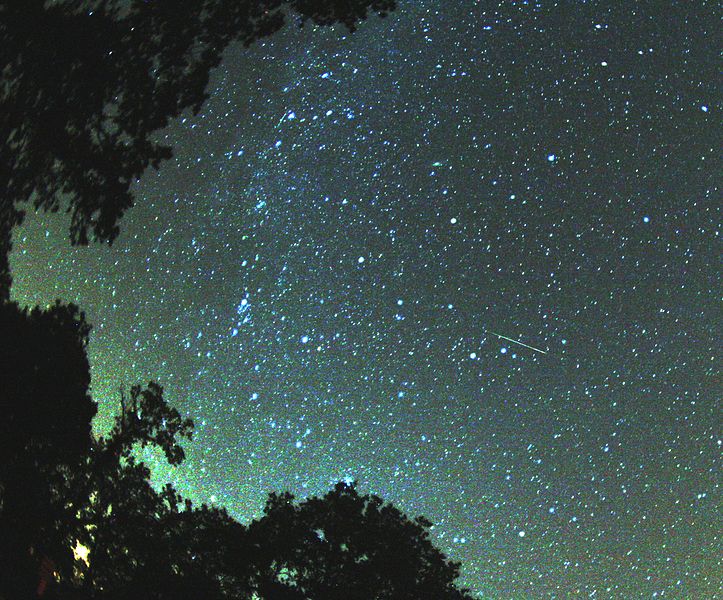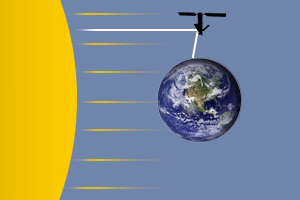Perseids: report from the Pushchino Radio Astronomy Observatory

Perseids
Astronomy lovers know that every year in the first half of August in the sky you can observe a beautiful astronomical phenomenon - Perseids. It is active from July 17 to August 24, and its maximum usually falls on August 12. This astronomical show is directly related to the Swift-Tuttle comet.
Comet Swift-Tuttle has a circulation period of 135 years, and the last time we could see it was next to our planet in 1992. But, despite the fact that its next appearance is planned only in 2126, we can observe the trace of this comet annually. She lost the smallest particles of her substance in orbit, and the Earth annually during its journey around the Sun passes through this trail.
As a result of the passage of the Earth through the plume of dust particles, a meteor shower is formed. If you draw straight lines through trajectories drawn in the sky by meteors, they converge at a point located in the constellation Perseus, which is why the stream got its name.
The most abundant stream of particles was observed, naturally, the next year after the comet approached the Earth. But even in a typical year, the number of traces of meteors that can be seen in the sky reaches 60 pieces per hour - that is, on average one every minute. In the same year, astronomers calculated that we would fly through a particularly productive part of cometary particles, as a result of which the average number of tracks could be 100 per hour.
Pushchino Radio Astronomy Observatory
Your submissive was able to attend the annual festival organized by employees of the Pushchino Radio Astronomy Observatory of the FIAN ACC in the Moscow Region. This is the oldest scientific institution in Russia dealing with radio astronomy, which was founded on April 11, 1956, initially based on the work of a permanent expedition to the Crimea, which had been operating since the late 1940s.
Sunspots
Under the strict guidance of Vladimir Alekseevich Samodurov, senior researcher at the observatory, free-of-charge science festivals are held in PRAO twice a year, and people of all ages who are interested in astronomy come to it. The first festival of the year takes place on Cosmonautics Day, the second - on the weekend next to August 12th.

Samodurov V.A. /photo from the event’s forum page
The observatory organizes popular science lectures, planetarium visits, a cultural program and a night sky tour. Dozens of enthusiasts, amateur astronomers who come from Moscow and the region with their telescopes, and, sitting on one of the institute's fields, help her with pleasure show visitors various celestial objects, including the Sun through special filters, and various stars and nebulae.

Amateur astronomers with equipment prepared for observing the Sun / photo from the event forum page

On a tour / photo from the event forum page
PRAO was built in 1956 in the area of the village of Pushchino on the right bank of the Oka River, about 15 km downstream from Serpukhov, on the former collective farm field. An observatory was allocated a site of 148 hectares, on which the RT-22 telescope was the first to grow - one of the oldest radio telescopes in Russia with a 22-meter diameter plate.

Also on the territory of the institute you can see the DKR-1000 - a 1000-meter cross-shaped Cross-shaped Radio Telescope. This is a meridian type radio telescope with an empty aperture - consists of two antennas North-South and East-West, arranged in the shape of a cross. Each antenna is a tower with a crescent-shaped swivel attached to them. Designs are connected in one unit by numerous wires.

On the tour we managed to see firsthand the change in the angle of inclination of the rotary structures - it was a mesmerizing smooth movement, passing under the low measured drone of simultaneously working engines.
Another unique design available to the PRAO, and not at all like a telescope, is the BSA, a large scanning antenna. This is a meridian-type radio telescope with a filled aperture. It is a flat lattice of 16384 wave dipoles measuring 187 × 384 m. The dipoles are located on wires stretched between the posts and passing at a height of about 2.5 m from the ground.

PRAO employees also work in the international space project Radioastronwith leading Russian participation. This is a project for the interaction of the Spectrum-R spacecraft equipped with a radio telescope with ground-based RTs. The device, launched in 2011, is located at a distance of about 340 thousand km, which is comparable to the orbit of the moon. His joint work with terrestrial radio telescopes allows you to obtain data that previously were not available to scientists. After all, the resolution of the radio telescope depends on the length of the base - at first this length was increased, arranging networks of ground-based radio telescopes, and when the planet was not enough in size, unmanned astronautics came to the rescue.
Night sky
On August 8, the night sky pleased all lovers of astronomy - the beautiful weather contributed to the observations. Although the nights were still quite bright in the first half of August, nevertheless, you could see many interesting objects in amateur telescopes - the Andromeda nebula (M31), the globular cluster of Hercules (M13, which I liked most), the Ring nebula (M57), The Veil Nebula , the planet Uranus, and, of course, various stars and asteroids. Illumination

map
Due to the remoteness of 100 km from Moscow, the sky was not very illuminated by artificial lighting. With such naked eyes in such conditions you can see the Milky Way and many different constellations, the Summer Triangle(three bright stars Vega (Alpha Lira), Deneb (Alpha Cygnus) and Altair (Alpha Orla)), not to mention the Big and Little Dipper, the Polar Star and other famous objects.

Astronomy lovers during the observations The
“flash of Iridum”, a solar bunny that periodically rotates a communications satellite, casts its antenna onto the Earth, successfully coincided with a night tour. Thanks to the well-known satellite motion parameters, the time and place of the outbreak can be accurately calculated. At 0:18 in the sky with the naked eye, a very bright, short-term (several seconds) flash became visible, which at the peak reached a magnitude of -8, overshadowing all the other stars.

For the first time in my life I saw a “shooting star”, and I advise everyone to at least once experience this feeling, and in general, take a walk somehow in the night sky. To do this, you do not need expensive equipment at all - you can get by with the naked eye or, for example, inexpensive binoculars.
You just need to arm yourself with a flash map , choose a place to observe, and enjoy the beauty of the night sky. During the appearance of Perseids, meteor tracks appear very often - but at any other time it is enough to stare at the sky for half an hour, and you will definitely see a trace from some meteor. If you do not navigate in the night sky, numerous PC programs or smartphone applications can help with this, which will show the location of all the objects that should be visible from your place at this time.

